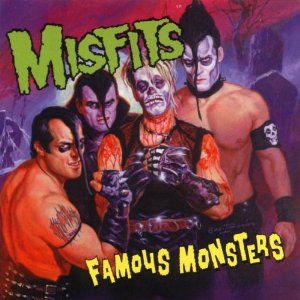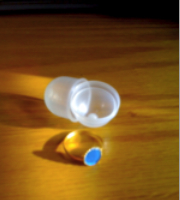So, picking up where we left off in the February 27th post, we’ve been discussing influences on the writing of the first Pandora Zwieback novel, Blood Feud. Last time I talked about how the Horrorpops song “MissFit” became Pan’s anthem. Now we get to the introduction of her gothy friends.
There’s a scene in chapter 21 in which Pan and her friends do a little song-and-dance number for videographer Tim Merrick (whose day job is working as an assistant to David Zwieback, owner of the storefront museum Renfield’s House of Horrors and Mystical Antiquities). When I started writing that scene, the first horror-related tune that popped into my head was Michael Jackson’s “Thriller.” A classic 1980s pop hit, with a good beat and lyrics, and Vincent Price rapping—what better song for Pan to launch into?
Yeah, okay, it was too easy a musical choice, and way too mainstream a tune for Goths, but I was trying to find a way to make a transition between a scene in Renfield’s, during which Pan has lovingly bullied her father into retrieving her makeup kit from his car, and the dance number on the museum’s basement steps. As originally written, it went like this:
The door swung shut behind him, and Pan turned to face Tim. He looked highly amused. “What?”
Tim shrugged. “Just couldn’t help noticing you got him trained well.”
“Of course.” Pan flashed a wicked grin. “And now, Timothy,” she intoned in her deepest, most ominous voice, “at last you know the true power of being Daddy’s Little Girl…”
* * *
“ ’Cause this is Thrillllerrrrr!” Pan wailed, head thrown back, as she and the crew sang along with Michael Jackson and danced on the steps leading to the museum’s basement floor.
In movie terminology, I saw the transition as a smash cut: an abrupt jump from one scene to the next—in this case, everyday Pan giving her best sinister smile instantly changing into glammed-up Pan singing her heart out as the “camera” pulls back to show her and her friends on the stairs. (If you’ve been following these posts, you already know how I tend to “see” the scenes I write in cinematic angles.)
 But then one night I downloaded the latest episode of Rue Morgue Radio (a great online, F-bomb-loaded radio-style show that stopped broadcasting in January 2012 after seven years, but you should definitely check out their archives). One of the first songs that the host, Tomb Dragomir, played was a track from the Misfits’ 1999 album Famous Monsters: “Fiend Club”—and I suddenly realized that Pan & Co. had a much better song to perform:
But then one night I downloaded the latest episode of Rue Morgue Radio (a great online, F-bomb-loaded radio-style show that stopped broadcasting in January 2012 after seven years, but you should definitely check out their archives). One of the first songs that the host, Tomb Dragomir, played was a track from the Misfits’ 1999 album Famous Monsters: “Fiend Club”—and I suddenly realized that Pan & Co. had a much better song to perform:
http://www.youtube.com/watch?v=n5TgEU4f_eY
We won’t pretend that this is the end
We’re not losers all of the time
We march and we fall
We’re one and for all
It’s just evil all of the time
All the time
We are the fiend club
We are the fiend club
We are the fiend club
Not you! Not you!
You dress so messed up
Your hair is too long
But I’m changing it all of the time
We march and we fall
We’re one and for all
It’s just evil all of the time
All the time
Evil all the time
We are the fiend club
We are the fiend club
We are the fiend club
Not you! Not you!
Evil all the time
We are the fiend club
We are the fiend club
We are the fiend club
Not you! Not you!
We are the fiend club
Not exactly a song you can choreograph a dance number to—well, not unless it includes a lot of violent head banging—but I thought, what a great anthem that would make for Pan and her friends: united in their weirdness, and proud of it. So, out went the King of Pop and in came a far more appropriate band (who are horror fans themselves).
FYI: The actual Fiend Club is the Misfits’ fan club. You can find it here.


 But then one night I downloaded the latest episode of
But then one night I downloaded the latest episode of  One of my short stories, “Laundry Day”—about a group of people trapped while doing their wash on the eve of a zombie uprising—got its start from a toy ring that I bought from a gumball machine in a neighborhood Laundromat. What popped into my head when I first saw the machine full of rings was a scene of a guy presenting this crappy, 25-cent jewelry to his girlfriend as a romantic gesture, knowing they’d never have the chance to get married. The “camera” in my head then pulled back to reveal them huddled inside a Laundromat that had its metal security gates pulled down; beyond the gates was a full-on zombie apocalypse. (Yes, a lot of what I “see” when I write involves Hollywood-style cinematography.)
One of my short stories, “Laundry Day”—about a group of people trapped while doing their wash on the eve of a zombie uprising—got its start from a toy ring that I bought from a gumball machine in a neighborhood Laundromat. What popped into my head when I first saw the machine full of rings was a scene of a guy presenting this crappy, 25-cent jewelry to his girlfriend as a romantic gesture, knowing they’d never have the chance to get married. The “camera” in my head then pulled back to reveal them huddled inside a Laundromat that had its metal security gates pulled down; beyond the gates was a full-on zombie apocalypse. (Yes, a lot of what I “see” when I write involves Hollywood-style cinematography.)